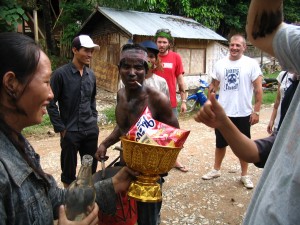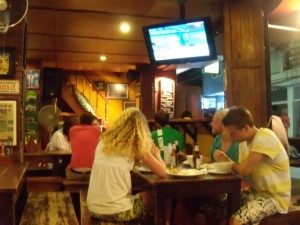I finished reading China Miéville’s The City and The City recently. If you have read the book, you can skip down to Reactions. The book takes place in two separate cities, Besźel and Ul Qoma, that are in the same place geographically, while legally being in two different countries. A murder mystery is used as a means to explore this mechanic of the two intertwined cities, where a detective, Tyador Borlú, discovers that the victim has been moved to his city (Besźel) from the other city (Ul Qoma) and he must travel from his city to the other. However, this is a journey of psychology and perception, not geographical distance. While a certain road or square may be in one city rather than the other, many areas are “crosshatched”, where they simultaneously belong in both cities. A quote from the book describes this well as Borlú is walking to meet a witness:
In Besźel the area was pretty unpeopled but not elsewhere across the border, and I had to dodge many smart young businessmen and -women.
A citizen of either city must learn to “unsee” and ignore members of the other city. Buildings themselves may even be cross-hatched, with individual rooms belonging to one city or the other. If people who are in two separate cities interact personally, this counts as a crime, and Breach, somewhat of an inter-city police force, is called in to clean things up, trumping local laws. Breach also deals with events like car accidents, where a car in one city may crash into anything in the other city. According to each city’s own laws, they are separate and Breach only deals with issues where the two cities interact accidentally. One of the best things about this book is that The City and The City purportedly exists in modern-day eastern Europe, and there is the internet, Google and visiting academics from Canada and the U.K. You can phone someone from the other city, although the connection is not very good. However, you cannot stop that same person on the street and greet them. One can legally travel from one city to another by passing through a customs-like building at the centre of both cities, Copula Hall.
On the street, one can tell who is in what city based on styles of clothing, posture and mannerisms. Certain colours are illegal in one city or the other, presumably as a way to tell who is in which city. There a fantastic chase scene near the end where a criminal is on the run, and police from both cities are after him, but as he is a foreigner and was raised in neither city, he is an expert at the mannerisms and walking styles of both, and manages to walk between both cities. Thus, neither police force can touch him, as this would invoke Breach, which is much worse.
Reactions
While the novel seems quite far-fetched, it struck me at the end that the opposite was true. It does something that is common in good speculative fiction: calling attention to something implicit in the real world by making it explicit. Some of the laws and habits of the citizens of The City and The City seem far-fetched, but consider the social appropriateness of the following time and space violations in Canadian society:
– driving on the left side of the road
– standing in the doorway of a store
– hugging everyone on the subway
– following someone around continually
– walking diagonally through an intersection
– walking into a room with an ongoing meeting without trying to be quiet
– ignoring a line and walking to the front
– walking into a kitchen of a restaurant
– opening and eating food that is on display at a corner store
– sitting on someone else’s lawn
All of the above are violations of the social contract. We have constructed legal and social systems that give definitions to certain areas of time and space, and it is impossible to function in a society unless you know what they are. The City and The City may be slightly more crazy, but rules are rules. It isn’t discussed at length in the novel what is fundamentally different both cities, other than that they seem to have separated around two millennia ago.
Its fascinating how we treat people who behave outside the rules. Social rules are required a priori before we can even start interacting with someone. When someone breaks the rules, it suddenly becomes frightening and impossible to deal with them (like a stranger quietly hugging you on the subway, which happened to me recently). In The City and The City, when a breach happens, citizens of both cities are typically frozen in shock until Breach (the organization) appears and reorganizes things by explicitly separating the undesired interaction between the two separates systems, and allows both to function on their own.
Trying standing on some well-populated intersection, and you will certainly see divisions between people. Certainly not as severe as The City and The City, but you see different groups of people interacting in different ways. I find that Spadina and College in Toronto is a really good place for this. It is right above Chinatown, there is a homeless shelter and the Center for Addiction and Mental Health nearby, as well as the students from the University of Toronto and hipsters from Kensington Market. Lots of different groups in the same physical space, with varying levels of interaction between them.

Journeying and not Journeying
I like journeying to see the other. Mostly because I want to find what I like about the other’s culture and assimilate it into my own. I’ve been to Southeast Asia twice, and it felt different both times. The first time was with my friend Taylor in 2007, and we tried to live as low to the ground as possible, using the local language (poorly) as often as possible, eating only local food, hanging out in markets, etcetera. We used the term “cultural tourism”, and went drinking with tuk-tuk drivers. The second time was with my friends Jack and John, who I had not seen in over a year. We were there for a shorter period of time, mostly to hang out with each other and go scuba diving and be beach bums. Slightly different geographical spaces (first time I went north, second time I went south) but the same cultural space. But when we walked we walked in different places. Jack and John may no effort to eat local food, which I found hilarious as I made about 1/3 of the price for every meal, which was almost always Pad Thai.

I loved both trips, but somehow how I saw the world around me, based on the people with me, was different. While I would say I had more “fun” on the second trip, I felt very detached from my surroundings. I was in the place that Jack and John and I had constructed, and not the Thailand I recognized from before.
2 responses to “Journeying (inspired by The City and The City)”
Eating Western food had something to do with Jack & I spending months in Nepal & India previous to that…. it was pretty nice to eat something that wasn’t dhal every day!
Yeah, you got me there.